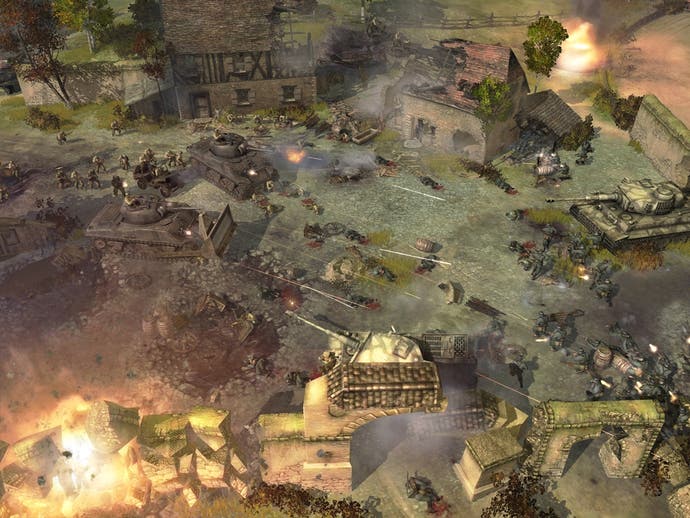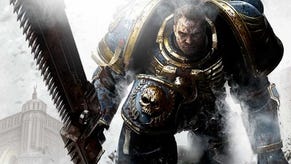Company of Heroes
Heroic effort from the folks behind Homeworld.
There are two things you're inevitably going to run into during any given five minutes on the E3 show floor this year. The first is an overweight, bearded, pasty white programmer with male pattern baldness using words like "fronting", "representing", "tricked out" and "pimping", and sometimes even making rapper hand motions, in an attempt to seem as "street" as possible while presenting his company's latest and greatest GTA clone. This is, as Pat would say, all a bit wrong. The second is the ear-shattering, eyeball-endangering spectacle of World War II being brought to life in more stunning reality than ever before - except, er, when it was actually happening. Obviously.
World War II is hot right now - so much so that a couple of publishers have started describing it as a genre in its own right. To use publisher parlance, then, Company of Heroes would be THQ's key entry into the World War II space - but while the content may seem familiar, and the name may follow the rather familiar X of Y pattern, veteran developer Relic has thankfully gone quite a way to making a game that stands apart from the competition in almost every way.
Heroic Strategy

Our introduction to Company of Heroes sees us on familiar ground - a town in war-torn Europe which is the site of a major struggle between the Allied and Axis forces. Swooping camerawork brings us from overhead views right down to the heart of the action, revealing incredibly detailed buildings, soldiers and vehicles. A force of Allied troops advances towards a heavily fortified square, moving from cover to cover and ducking under heavy fire from the entrenched enemy forces. The camera joins an American soldier who has made his way to the top of a half-destroyed building, and is sniping down at the German forces from there, then pans back over the incredibly detailed makeshift fortifications in the square.
Graphically, it's stunning; everything is high resolution and beautifully modelled, with smooth, realistic animation on all the troops and great lighting and effects. Battle is joined with a ferocity that few other WW2 games could hope to match, with streams of bullets kicking up sprays of dirt or knocking plaster off walls, explosions knocking cobblestones out of the roads and artillery fire demolishing chunks of buildings with realistic physics.
It's as we're gawping at the visceral majesty of the carnage - which is, quite honestly, one of the most visually attractive WW2 games we've ever seen - that our PR gal drops the bombshell. "Er, it's probably not very clear," he says, "but this is a real-time strategy game."
He's right. It wasn't very clear until now. We're looking at a game which honestly isn't that far off the bar being set by Call of Duty 2 on the Xbox 360 in terms of its up-close graphics. This is a game where battle-worn tanks come smashing through walls with full physics in action, where buildings topple and the blast of heavy weapons fire will genuinely make you wince from the sheer hammer blow it deals. Up-close, it's got the kind of intensity that many of the ubiquitous World War II first-person shooters would kill for (and not just kill about seven thousand German soldiers for, either).
He's not kidding, though. The camera zooms out, and suddenly we're seeing the area from a more traditional RTS viewpoint. It still looks fantastic, but now with load of units on-screen at once. This is a Relic hallmark, in ways; the creator of Homeworld, Impossible Creatures and more recently Warhammer 40,000: Dawn of War has always loved allowing strategy players to get up close and personal with the action in a way which few of their competitors can rival. It's all about the spectacle with Relic, and the team has certainly created quite a spectacle with Company of Heroes.
Sweep and Clear

Unfortunately, jaw-dropping graphics aside, details about the game itself are a little thin on the ground. Relic is just teasing us with a glimpse of the game right now - but we do know that the company plans to continue with another of its signature design features, namely that the story will be told mostly in-mission through a sequence of short in-engine cut-scenes triggered by your actions in the game, rather than by lengthy exposition between missions.
The company also revealed that the game will include a resource system, rather than following in the path of other WW2 strategy titles with tactical play which gives the player a fixed number of units for each mission. How exactly the resource system and unit "building" will work is unclear, but Relic did hint that it would be an evolution of the control point system which it has used in some previous games.
Realism is also high on the menu for the game, and not just in the great graphics and Havok-powered physics. Units don't take damage in the traditional health-bar sense in Company of Heroes - instead, tanks and other vehicles will take damage to their systems depending on where they're hit, impairing their performance before they're finally destroyed, and the different armour on the bodies of various vehicles will be taken into account - so it'll be easier to take a Tiger tank out with a bazooka shot to the back or sides than by attacking the heavily armoured front, for example.
On a show floor which has seen more World War II action than 1944, Company of Heroes manages to stand out not just because it's a strategy game, but because of its graphics, physics and gritty realism. Relic is kicking the bar up significantly in the RTS space - and this is definitely one for PC owners and strategy game fans to keep a close eye on as we get closer to its planned 2006 release date.







